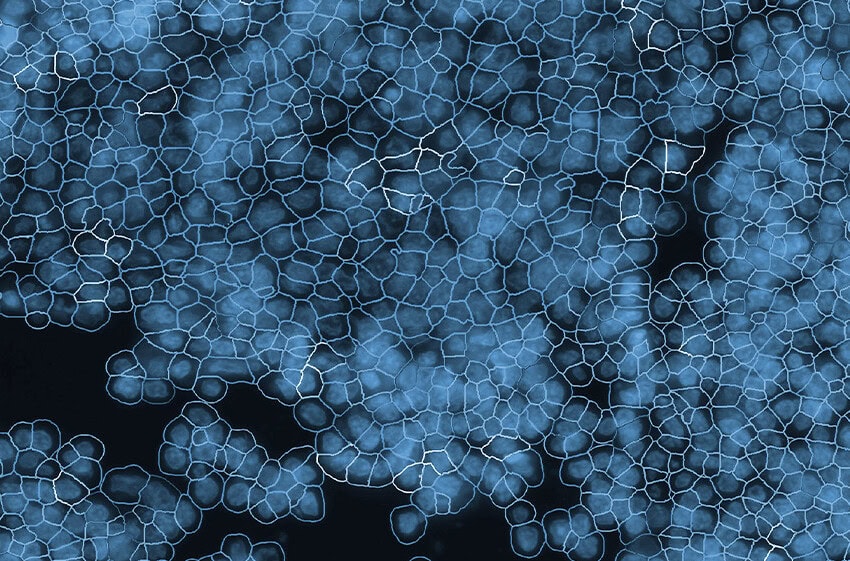
Q&A with Drs. Torsten Nielsen and Tony Ng and Angela Goytain: Development of a Sarcoma Gene Fusion Assay Faster Than FISH and Simpler than NGS
The NanoString nCounter is Research Use Only and not for diagnostic use. The views expressed herein are solely those of the interviewed researchers.
Torsten Nielsen, MD, PhD is a pathologist and clinical scientist at the University of British Columbia (BC) in Vancouver, Canada. He studies sarcomas and breast cancer at a clinical level and runs an active research lab developing new diagnostics and therapies for those cancers.
Tony Ng, MD/PhD is a clinical pathologist and physician scientist at the University of British Columbia working in molecular diagnostics and translational cancer research. As a head and neck pathologist and sarcoma pathologist he is particularly interested in identifying biomarkers and molecular diagnostics of these tumor types.
Angela Goytain is a senior research technician and runs the sarcoma research lab in the Jack Bell Research Pavilion.
NS: What distinguishes sarcomas from other types of cancer?
T. Nielsen: Sarcomas arise from mesenchymal cells—the cells that give rise to bones and soft tissue. That’s actually most of the tissue in your body! The concept of a sarcoma encompasses a vast number of tissue types so there’s a wide diversity in the number and types of cancers under the umbrella term “sarcoma”. As they occur mostly in fast growing tissues, sarcomas are less common in adults than other types of cancer; young adults and children are disproportionately higher-risk population. Sarcomas are characterized by fusion proteins, where parts of two different proteins have come together abnormally to give rise to the cancer.
NS: What is the role of fusion oncoproteins in sarcomas?
T. Nielsen: Sarcomas are one of the cancers where gene fusions were identified early as a common molecular mechanism driving the biology. The most famous ones were in lymphomas and leukemias, going back to the Philadelphia chromosome. The original technology was classic karyotyping looking for large scale repeated chromosomal changes. By the 1980s, it was recognized that sarcomas were the other cancer type with consistent translocations. Subsequent work to clone these translocations using PCR-based technologies identified the genes that were fused. Many of these sarcomas affect young people with a relatively “quiet” cancer genome background so it’s the fusion protein that is driving the disease. This is different from more common cancers where next generation sequencing finds a whole host of fusions and other mutations but many are not repeated or are passengers. These kinds of changes are indicative of genomic instability and we can’t tie them to diagnosis or treatment. In sarcomas, a fusion is usually pathognomonic for the diagnostic entity and drives its entire biology. That one fusion oncoprotein sets off a whole program of changes that alters the state of the mesenchymal cell to drive sarcoma. That’s the biology that is central to the diagnosis and treatment.
T. Ng: Even though the fusion protein is the driver there is additional complexity to the whole system. The same fusion can be seen in multiple tumor types and multiple sarcoma types. On the flip side, the same sarcoma type can express multiple fusion genes, fusion partners, and variants. All this variability highly increases the complexity of the transcripts present and subsequently factor into the design of our assays.
NS: Tell us about the history of treating sarcomas at Vancouver General Hospital and Vancouver Coastal Health.
T. Nielsen: Sarcoma care is centralized in the province of British Columbia. There’s a lot of data that supports this as the best way to care for uncommon diseases as it creates a critical mass of relevant expertise. Almost all patients in BC get referred to Vancouver General Hospital as the definitive point of surgical care. These patients are managed by a full multidisciplinary team of pathologists, surgeons, medical oncologists, radiation oncologists, and radiologists. Every Monday morning all the major centers in the province connect by video conference to discuss new and current patients with sarcoma issues. There are 50 different kinds of sarcomas and so the right diagnosis is critical to care management. There’s not one clear “right” pathway for diagnosis and care so multidisciplinary collaboration is critical.
T. Ng: We have one centralized cancer agency that organizes cancer care across our province of four million people so we can tap into a lot of expertise and have a lot of visibility into different types of sarcomas. This results in unusually high access to tissue samples for developing and testing new assays. Because we serve the whole community of BC residents we see a spectrum of sarcomas more representative of a general population than what might be typically seen in a privately-run cancer center.
NS: What are the current challenges in developing a sarcoma gene fusion assay?
T. Ng: There’s a lot of variability in the gene fusions that each tumor type can have. Especially in sarcomas, it seems like every week a novel variant comes out that can be associated with diagnosis and clinical therapy. In terms of developing an assay, it starts with a defined code set that then changes over time.
A. Goytain: The sheer number of potential variants for a fusion gene makes assay development a challenge—there’s small changes, repetitions, insertions, deletions. Trying to fit all those combinations into a single assay and prioritize them is an ongoing balancing act.
T. Nielsen: Another challenge is just maintaining the tests. When testing was done by fluorescence in situ hybridization (FISH) we had to have a whole suite of individual FISH probes to cover all the translocations. Each of those required regulation and quality control; this made it difficult to develop new tests when new translocations were identified. *NanoString presented an approach that was efficient, cost effective, had a faster turnaround time, and could replace the whole suite of forty or so tests with a single test that covered all of what we needed.
NS: Before you implemented NanoString’s technology how were you detecting sarcoma gene fusions?
T. Ng: We used a lot of FISH and it involved looking at one gene at a time. It was a time consuming and iterative process that was not ideal for diagnosis compared to a panel approach.
T. Nielsen: In the past when we had to go wide and cover everything in one test if we wanted to find something that wasn’t in our FISH panel then we had to go back to basic karyotyping. PCR was used but then we ran into not just multiple genes but multiple splice points.
A. Goytain: When FISH was not available for the target gene or the FISH was inconclusive, I assessed the most likely fusion by PCR. For many of the fusions I needed to use multiple primer pairs in order to cover all the splice points. I might have ten primer pairs just to try to capture one fusion protein. Add in the fact that qRT-PCR on FFPE tissues is already difficult because the RNA transcripts are often fragmented and the process became even more cumbersome.
NS: How did you first hear about NanoString?
T. Nielsen: I heard about NanoString several years ago when we had developed a PCR-based panel test for breast cancer and were looking for a technology platform to deliver that panel. Multiplex PCR had frustrating limitations that restricted us to a low number of analytes within an assay. NanoString was a new technology and when we used an early prototype we saw it really did give us reliable, digital, quantitative RNA measurements over a wide dynamic range using tiny fragments of low-quality RNA from FFPE blocks: just what we needed for clinical implementation. I continued to collaborate with NanoString on what became the Prosigna assay, making NanoString’s nCounter technology the obvious choice to use for this new problem of sarcoma fusion detection.
T. Ng: I partnered with Dr. Nielsen and Dr. Kenneth Chang, a visiting pediatric pathologist from Singapore. In 2015, the four of us began to develop a sarcoma gene fusion assay quite quickly, leveraging what Dr. Nielsen had learned from the assay development for Prosigna.
NS: How did you go about designing the sarcoma gene fusion assay?
A. Goytain: We started with a deep literature search to identify and include as many fusion proteins as possible. The focus of our initial assay was to try and cover as many of the same fusions as a panel that was already being done with NGS.
T. Ng: After we designed the assay there was a lot of work to be done around validation. It’s not possible to just assume the codeset we designed works. With sarcomas one big challenge is to have enough cases to try to cover as many of the fusions in our assay as possible. Fortunately, using archival pathology cases in British Columbia, we have access to a lot of adult sarcoma samples and through our collaboration with Dr. Chang in Singapore we had a lot of pediatric sarcoma samples as well. These samples were key to the validation study we published that looked at 200 cases with high sensitivity and specificity using our assay.1K TE Chang, Goytain, T Tucker, A Karsan, C Lee, TO Nielsen, TL Ng. Development and Evaluation of a Pan-Sarcoma Fusion Gene Detection Assay Using the NanoString nCounter Platform. Journal of Molecular Diagnostics 2018 Jan; 20(1):63-77
NS: How did the NanoString nCounter facilitate your assay development?
A. Goytain: Initially we ran about fifty cases on the nCounter that were confirmed by FISH. As the FISH confirmation relied on identifying just one gene of the fusion transcript we did PCR for all the initial cases to validate the specific break points detected on the nCounter. To confirm the variants detected in the NanoString assay, we used both PCR and NGS to demonstrate the detected fusion was correct.
T. Ng: The NanoString assay would ultimately reveal more information than the initial FISH assays. Importantly, we had a few instances where the FISH data were insufficient and inconclusive in detecting a particular variant, but it was readily detected by the NanoString platform.
T. Nielsen: The biggest advantage of the NanoString system is that it is “plug and play” and yet highly adaptable to our research.
NS: What were some of the validation results that gave you confidence in the robustness of the assay?
T. Ng: The diagnosis of sarcoma is more than a molecular diagnosis and identification of a fusion protein—it involves histology, immunohistochemistry (IHC), and molecular features. When we get a positive molecular result, we correlate it with those other assays to confirm the diagnosis. For example, the molecular diagnosis of Ewing Sarcoma is critical in pediatric and young adult patients because it drives a specific chemotherapeutic regiment and treatment protocol. We looked at many cases for that fusion and diagnosis. Within the twenty cases we examined we were able to detect all of them with the NanoString platform. The Chang lab in Singapore provided independent confirmation of the reproducibility of the assay.
NS: How does the assay fit into your current workflow?
T. Ng: Adapting the assay has been relatively straightforward. We have both a provincial molecular lab and our smaller clinical molecular diagnostics lab for novel assays. Both the lab and the assay are accredited. Our assay is now a routinely run on samples from across the province as well as outside consultation cases throughout Canada. We run three to six cases as a batch each week and get results the next day. Every sample also includes a quality control metric using housekeeping genes. We’ve got a reporting mechanism using our existing pathology system where we can incorporate the molecular results with the histological diagnosis.
NS: What has been the response to the assay from the global sarcoma research community?
T. Ng: There has been a lot of international interest in evaluating the assay. We’ll share the codesets and/or assay design for others to replicate it. We’ve also received samples to test from around the world. We’ve already discovered some fusions that could not have been detected using current techniques.
NS: What’s next for your group?
T. Ng: The sarcoma assay continues to evolve as we winnow out less useful fusion variants and include novel variants to improve the assay. We are getting close to completing an assay for salivary gland tumors. This is an unusual tumor type but we study it because this carcinoma also tends to be driven by fusion genes. We are also investigating aspiration cytology samples; they tend to be limited in the amount of sample available to test, making it difficult to diagnose.
NS: What advice do you have for other clinical researchers who are looking to bring NanoString technology into their lab?
T. Ng: In adapting the technology to study gene fusions, the main limitations are not in the NanoString technology but in the sets of probes and the analytes. Everything needs to be well characterized and the probes need to be complementary to the targets. The real strengths of the NanoString platform are the quick turnaround time, the robustness, and ease of use. It’s ideal for our use in adapting research assays with FFPE tissue to a clinical research setting.
Related websites
http://www.gpecdata.med.ubc.ca/torsten/
https://pathology.ubc.ca/faculty/torsten-nielsen/
https://www.vchri.ca/researchers/tony-ng
https://pathology.ubc.ca/faculty/tony-ng/
Register for our webinars:
“Multiplexed lung cancer fusion detection without FISH or NGS,” Presented by: Dr. Leon van Kempen.
“Digital Detection of Sarcoma Fusion Genes,” Presented by: Tony Ng, PhD, FRCPC.
References
- 1K TE Chang, Goytain, T Tucker, A Karsan, C Lee, TO Nielsen, TL Ng. Development and Evaluation of a Pan-Sarcoma Fusion Gene Detection Assay Using the NanoString nCounter Platform. Journal of Molecular Diagnostics 2018 Jan; 20(1):63-77



